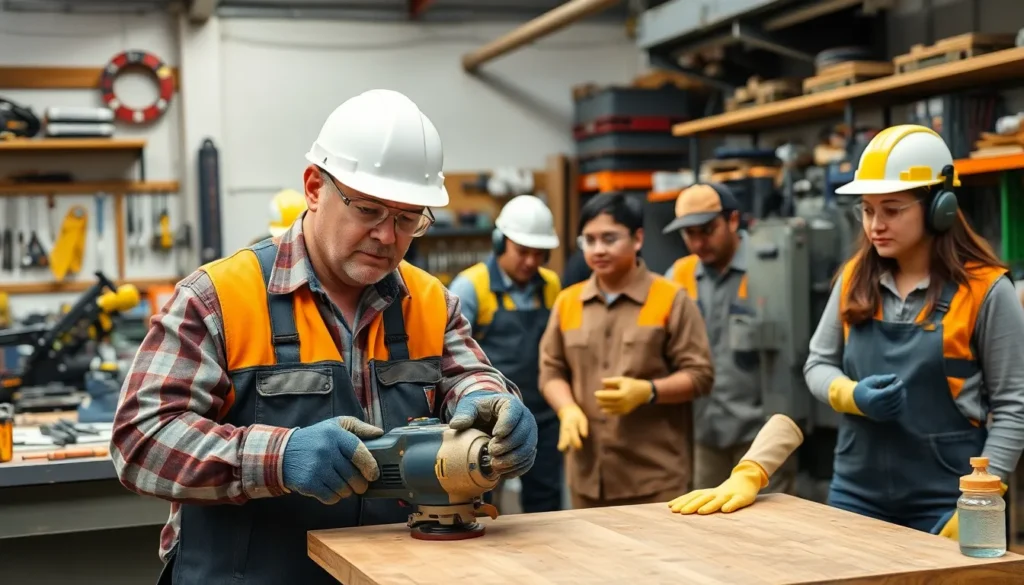Table of Contents
ToggleSafety in the workshop isn’t just a priority; it’s a necessity. Every year, countless injuries occur due to preventable accidents, underscoring the importance of a well-structured safety protocol. For anyone working in a workshop environment, understanding the key aspects of safety can mean the difference between a productive day and a trip to the emergency room.
From proper equipment handling to the significance of personal protective gear, workshop safety encompasses various elements that protect individuals and enhance overall efficiency. By fostering a culture of safety, everyone can contribute to a safer working environment, ensuring that creativity and productivity thrive without the looming threat of accidents.
Importance Of Workshop Safety
Workshop safety plays a pivotal role in preventing injuries and ensuring a productive environment. Many injuries stem from preventable accidents, underscoring the need for a proactive approach to safety. Implementing structured safety protocols minimizes risks, fostering a secure workspace for all individuals involved.
Personal protective equipment (PPE) is crucial in mitigating hazards. Workers must wear appropriate gear, such as gloves, goggles, and ear protection, tailored to specific tasks. Proper equipment handling also significantly reduces injury chances, ensuring tools are used correctly and maintained regularly.
Promoting a safety culture enhances not only protection but also creativity and productivity. When safety is prioritized, individuals feel more secure and are likelier to engage in their work fully. This results in efficient operations, a collaborative spirit, and overall workplace satisfaction.
Common Hazards In Workshops

Workshops present various hazards that can lead to injuries or accidents. Awareness of these hazards is essential for maintaining a safe working environment.
Physical Hazards
Physical hazards in workshops often include slips, trips, falls, and machinery-related injuries. Workers should ensure that the workspace remains clean and organized to minimize slips and trips. Proper use and maintenance of machines protect against entanglement and crushing injuries. Additionally, minimizing distractions and wearing appropriate personal protective equipment (PPE) help mitigate risks associated with lifting heavy items and working at heights.
Chemical Hazards
Chemical hazards arise from exposure to harmful substances like solvents, paints, and adhesives. Proper labeling, storage, and handling procedures must be in place to avoid accidental exposure. Use of Material Safety Data Sheets (MSDS) helps workers understand the risks associated with specific chemicals. Ensuring adequate ventilation reduces inhalation risks, while wearing gloves and goggles provides an additional layer of protection against skin and eye contact. Regular training on chemical safety practices further reinforces safe handling procedures.
Safety Equipment And Gear
Safety equipment and gear play an essential role in minimizing risks associated with workshop activities. Proper usage of personal protective equipment (PPE) and safety tools ensures a secure environment for all workers.
Personal Protective Equipment (PPE)
PPE includes essential items that protect individuals from workplace hazards. Common PPE items include:
- Safety Glasses: Protect eyes from flying debris and chemicals.
- Gloves: Shield hands from cuts, abrasions, toxic substances, and extreme temperatures.
- Ear Protection: Reduces exposure to harmful noise levels, preventing hearing loss.
- Respirators: Filters harmful particles and chemicals from the air, safeguarding respiratory health.
- Hard Hats: Guards against head injuries from falling objects or bumps.
- Steel-Toed Boots: Ensures foot protection against heavy objects and punctures.
Each worker must select the appropriate PPE based on specific tasks and identified risks. Regular training on proper PPE usage enhances effectiveness.
Safety Tools
Safety tools contribute significantly to a secure workshop environment. Key safety tools consist of:
- First Aid Kits: Contains essential medical supplies for treating injuries promptly.
- Fire Extinguishers: Designed to combat small fires; every workshop should have accessible extinguishers suitable for various fire types.
- Machine Guards: Prevent fingers or clothing from getting caught in moving machinery parts, reducing injury risk.
- Safety Switches: Immediately cut power to equipment in emergencies, ensuring swift action against hazards.
- Tool Organizers: Keeps tools organized and reduces accidents caused by misplaced equipment.
Employing these safety tools effectively fosters a culture of safety and reduces the chances of workplace injuries. Regular inspections ensure all equipment remains functional and accessible when needed.
Best Practices For Maintaining Workshop Safety
Maintaining workshop safety involves consistent strategies and practices that reduce risks and foster a secure working environment. Implementing regular inspections and proper training forms the backbone of these best practices.
Regular Inspections
Regular inspections of the workspace, tools, and equipment lead to early identification of potential hazards. Inspections should occur weekly or monthly, depending on workshop activity levels. Essential items to inspect include:
- Tools: Verify that tools are in good working condition and properly maintained.
- Equipment: Ensure all machinery has operational safety features, such as guards and emergency shut-offs.
- Work Areas: Keep aisles, exits, and work surfaces clear of debris to prevent slips and trips.
- PPE: Confirm the availability and suitable condition of personal protective equipment.
By scheduling inspections consistently, workers can address issues before they escalate into significant risks.
Proper Training
Proper training equips workers with the knowledge to use tools safely and respond effectively in emergencies. Training should cover several key areas:
- Tool Usage: Teach workers how to operate tools safely, including techniques for minimizing risks.
- PPE Training: Provide training on selecting, wearing, and maintaining appropriate personal protective equipment.
- Emergency Procedures: Educate workers on emergency protocols, such as evacuation routes and first aid procedures.
- Chemical Safety: Train workers to handle chemicals safely, including understanding Material Safety Data Sheets (MSDS) and using ventilation systems.
Regular refresher courses ensure that knowledge remains current and reinforces a culture of safety within the workshop.
Workshop Safety Regulations
Workshop safety regulations establish necessary guidelines to maintain a secure working environment. These regulations cover various aspects, including equipment usage, personal protective equipment (PPE), and emergency procedures.
Equipment Safety Regulations
- Installation Compliance: Equipment must adhere to safety standards outlined by relevant authorities, such as OSHA.
- Usage Guidelines: Operators need training specific to the machinery used. Regular updates on usage practices are essential.
- Maintenance Protocols: Scheduled inspections and maintenance checks ensure equipment remains in safe working condition and addresses any potential issues promptly.
Personal Protective Equipment (PPE) Regulations
- Appropriate Gear: Workers must wear gear suitable for specific tasks, including gloves, safety glasses, and respiratory protection.
- Accessibility: PPE should be readily accessible and fit properly to ensure maximum protection during tasks.
- Training: Regular training sessions guide workers in proper PPE selection and usage, reinforcing awareness of risks associated with task-specific work.
Chemical Safety Regulations
- Labeling Standards: All chemicals must feature clear labels indicating potential hazards. This ensures workers recognize risks associated with various substances.
- Storage Protocols: Chemicals require storage in designated areas with adequate ventilation to minimize exposure. Compatibility of chemical substances should also be considered.
- MSDS Availability: Material Safety Data Sheets (MSDS) must be accessible for all chemicals, providing essential information about handling and emergency procedures.
Emergency Procedures Regulations
- Emergency Plans: Workshops must develop clear emergency response plans that include evacuation routes and emergency contacts.
- Fire Safety: Fire extinguishers must be placed strategically throughout the workshop, and personnel should undergo fire safety training.
- First Aid Readiness: First aid kits must be stocked and easily accessible. Designated staff members should possess first aid training to respond to mishaps effectively.
Training and Compliance
- Regular Training: Workers require ongoing training concerning safety regulations, equipment operation, and emergency protocols to ensure compliance and awareness.
- Inspection Routine: Compliance with safety regulations necessitates regular inspections of equipment, PPE, and workspaces, with checks conducted at least monthly.
- Record Keeping: Documentation of training sessions, equipment inspections, and incident reports ensures adherence to safety regulations and aids in identifying areas for improvement.
Adhering to workshop safety regulations fosters a culture of safety, ensuring workers can operate effectively while minimizing risks.
Prioritizing safety in workshop environments is essential for creating a productive and secure workspace. By implementing structured safety protocols and ensuring proper use of PPE, individuals can significantly reduce the risk of accidents. Regular training and inspections foster a culture of safety that empowers workers to engage fully in their tasks.
Awareness of common hazards and adherence to safety regulations further enhance the overall safety of the workshop. When everyone takes responsibility for their safety and that of their colleagues, it leads to a more efficient and harmonious work environment. Embracing these practices not only protects individuals but also cultivates a collaborative spirit that drives success in any workshop setting.




